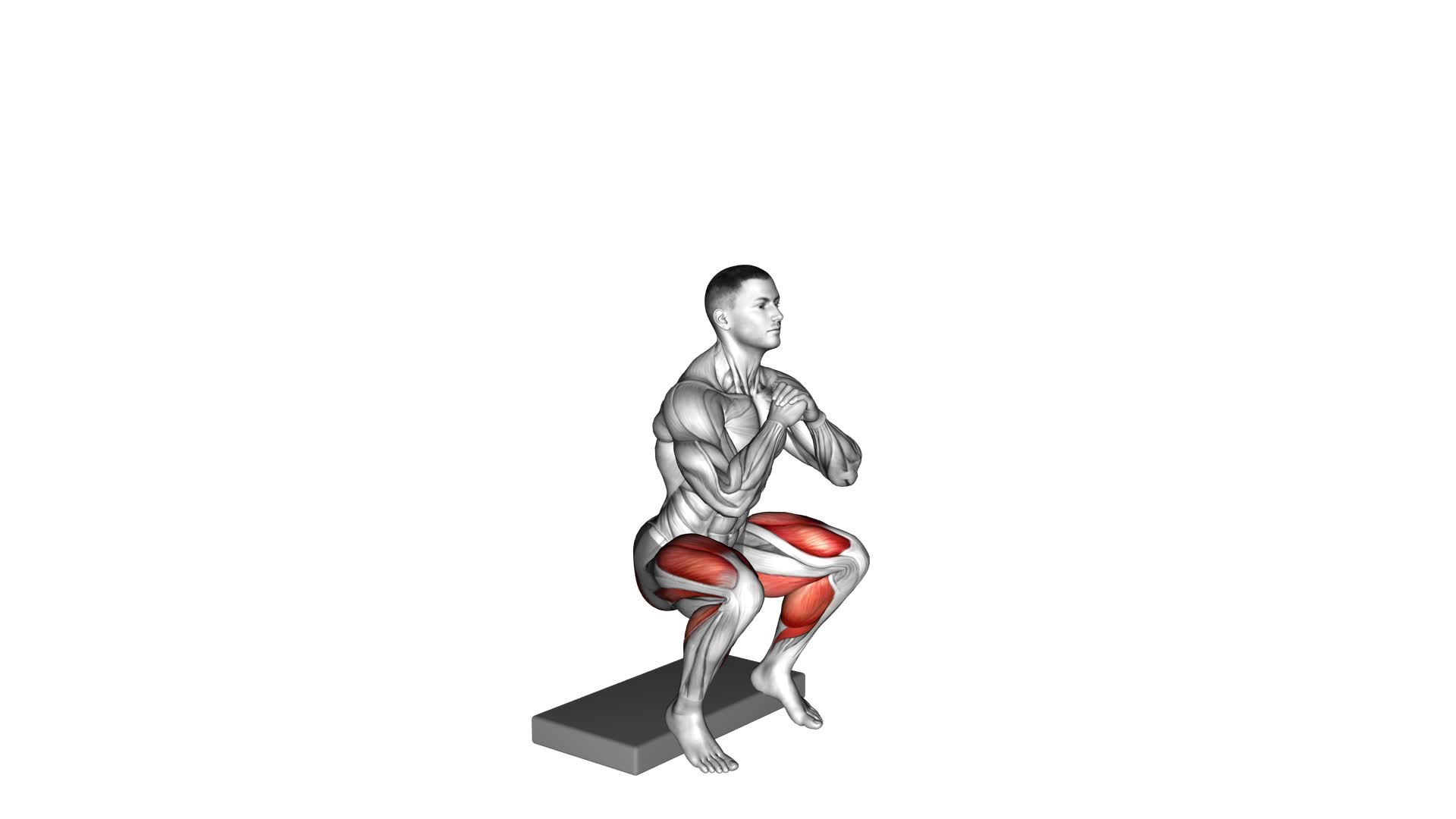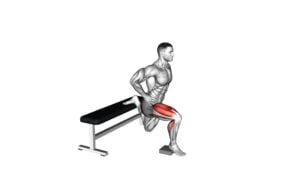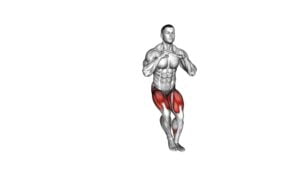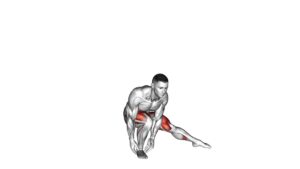Bodyweight Heel Elevated Squat (male) – Video Exercise Guide & Tips

Looking to strengthen your lower body? The bodyweight heel elevated squat is a great exercise to target your quads, glutes, and hamstrings. In this video exercise guide, we'll show you the proper form and technique for this challenging move.
Watch This Exercise Video
Plus, we'll give you tips on how to increase intensity and avoid common mistakes. Whether you're a beginner or advanced, this squat variation can be modified to suit your fitness level.
Let's get started!
Key Takeaways
- The bodyweight heel elevated squat increases lower body strength and stability.
- It targets the glutes, quads, and hamstrings effectively.
- The exercise improves balance and stability.
- The squat activates glutes more effectively than traditional squats, leading to stronger and more defined glutes over time.
Benefits of the Bodyweight Heel Elevated Squat
By performing the Bodyweight Heel Elevated Squat, you can increase lower body strength and stability. This exercise specifically targets the glutes, which are essential for everyday movements like walking, running, and climbing stairs. The heel elevation in this squat variation also helps to improve balance and stability.
The Bodyweight Heel Elevated Squat is a great way to strengthen your glutes because it activates them more effectively than traditional squats. By elevating your heels on a small platform, you shift the emphasis of the exercise onto your glutes, forcing them to work harder. This can result in increased muscle activation, leading to stronger and more defined glutes over time.
Additionally, this exercise helps to improve balance, as the elevated heel challenges your stability. By placing your weight on the balls of your feet, you engage the muscles in your feet, ankles, and calves, which are crucial for maintaining balance. This can be particularly beneficial for older adults or those recovering from injuries, as balance tends to decline with age and injury.
Incorporating the Bodyweight Heel Elevated Squat into your workout routine can help you build lower body strength, target your glute muscles, and improve balance and stability. Remember to maintain proper form throughout the exercise, keeping your chest up, knees in line with your toes, and engaging your core for maximum effectiveness.
Proper Form and Technique for the Exercise
To perform the Bodyweight Heel Elevated Squat with proper form and technique, you should start by positioning yourself with your heels elevated on a small platform. This exercise is great for improving stability and muscle activation in your lower body.
Begin by standing with your feet shoulder-width apart and your toes pointing slightly outward. Place a small platform, like a weight plate or a step, under your heels. This will elevate your heels and shift more of the emphasis onto your quadriceps.
Next, engage your core and keep your chest up as you initiate the movement by bending at your knees and hips. Lower yourself down into a squatting position, ensuring that your knees track over your toes and your heels remain elevated. Aim to lower until your thighs are parallel to the ground, or as low as you can comfortably go.
Tips for Increasing Intensity and Progression
To increase the intensity and progression of the Bodyweight Heel Elevated Squat, you can incorporate additional resistance or modify the exercise to challenge your muscles further. One way to increase difficulty is by using dumbbells or a barbell. Hold the weights at your sides or on your shoulders while performing the squat. This added resistance will engage your muscles more and make the exercise more challenging.
Another advanced technique is to elevate your heels even higher. You can use a step platform or place plates under your heels to increase the height. This will further emphasize your quads and glutes, making the exercise more intense.
Additionally, you can try performing the squat on one leg to further challenge your stability and strength. Lift one foot off the ground and squat down using the other leg. This variation won't only increase the difficulty but also target your muscles in a different way.
Remember to always maintain proper form and technique while incorporating these advanced techniques. By gradually increasing the difficulty and incorporating advanced techniques, you can continue to challenge your muscles and make progress in your Bodyweight Heel Elevated Squat.
Now that you know how to increase the intensity and progression of the exercise, let's move on to the next section to learn about common mistakes to avoid during the squat.
Common Mistakes to Avoid During the Squat
One common mistake to avoid during the squat is using improper form or technique. Proper form is essential to ensure maximum efficiency and minimize the risk of injury. Here are three common mistakes to avoid when performing squats:
- Leaning too far forward: This is a common mistake that puts excessive strain on your lower back and can lead to injuries. Make sure to keep your chest lifted and your back straight throughout the entire movement.
- Not going deep enough: Many people make the mistake of only squatting halfway down, not fully engaging their muscles. To get the most out of your squats, aim to lower yourself until your thighs are parallel to the ground. This will help to activate your glutes, hamstrings, and quads more effectively.
- Allowing your knees to cave in: When performing squats, it's important to keep your knees in line with your toes. Allowing them to collapse inward can put unnecessary stress on your knees and increase the risk of injury. To prevent this, focus on pushing your knees outward as you squat down.
Modifications and Variations for Different Fitness Levels
Choose the appropriate modifications and variations based on your fitness level to optimize the effectiveness of the Bodyweight Heel Elevated Squat exercise.
Modifying the exercise allows you to adjust the difficulty level and tailor it to your specific needs. If you're a beginner or have limited lower body strength, you can start by performing the squat without elevating your heels. This will provide a more stable base and make it easier to maintain proper form.
As you progress, you can gradually increase the difficulty by adding a slight elevation to your heels using a small platform or weight plates. This will require more strength and mobility in your ankles and calves.
For those looking for a greater challenge, you can try the single-leg variation of the heel elevated squat. This variation targets your muscles more intensely and improves balance and stability. To perform this variation, simply lift one foot off the ground and perform the squat with the other leg. Make sure to alternate legs to work both sides evenly.
Frequently Asked Questions
How Many Sets and Repetitions Should I Do for the Bodyweight Heel Elevated Squat?
To get the most out of the bodyweight heel elevated squat, it's important to know how many sets and repetitions to do. The number of sets and reps will depend on your fitness level and goals. Generally, starting with 3-4 sets of 8-12 reps is a good place to begin.
This exercise targets your glutes, quads, and hamstrings, and can help improve lower body strength and stability. There are also variations of this squat, like adding weights or using a stability ball, to challenge yourself even more.
Can I Incorporate Weights Into the Bodyweight Heel Elevated Squat for an Added Challenge?
Yes, you can incorporate weights into the bodyweight heel elevated squat for an added challenge. By holding dumbbells or using a barbell, you can increase the resistance and target your leg muscles even more.
However, it's important to start with lighter weights and gradually increase as you get stronger. If you're a beginner, it's recommended to focus on mastering the proper form and technique before adding weights.
This will help prevent injuries and ensure you get the most out of the exercise.
Is It Necessary to Elevate My Heels During the Squat, or Can I Perform It With Flat Feet?
To answer your question, it isn't necessary to elevate your heels during the squat. However, there are benefits to heel elevation in squats.
By elevating your heels, you increase ankle mobility and activate more muscles in your lower body. To perform a proper heel elevated squat, ensure your feet are shoulder-width apart, toes slightly turned out, and maintain a neutral spine throughout the movement.
Keep your weight on your heels and lower down as if sitting back into a chair.
Can the Bodyweight Heel Elevated Squat Help Improve My Vertical Jump?
To improve your vertical jump, incorporating bodyweight exercises like the heel elevated squat can be beneficial.
This exercise targets your lower body muscles, including your quadriceps, hamstrings, and glutes, which are crucial for explosive power needed in jumping.
By performing this squat variation, you can strengthen these muscles and improve your jumping ability.
Bodyweight exercises are convenient and effective for enhancing athletic performance, making them a great addition to your training routine.
Are There Any Specific Muscles That the Bodyweight Heel Elevated Squat Targets?
The bodyweight heel elevated squat specifically targets several muscles in your lower body. It primarily works your quadriceps, hamstrings, and glutes, helping to strengthen and tone these muscles. Additionally, this exercise also engages your calves and core muscles, further enhancing your overall stability and balance.
For athletes, the bodyweight heel elevated squat can offer numerous benefits, such as improved power, explosiveness, and vertical jump ability.
Conclusion
In conclusion, the bodyweight heel elevated squat is a highly beneficial exercise for improving lower body strength and stability. By maintaining proper form and technique, individuals can maximize the benefits of this exercise while avoiding common mistakes.
Furthermore, by incorporating modifications and variations, individuals of different fitness levels can adapt the exercise to their needs.
Remember to always challenge yourself and gradually increase intensity for continuous progression.

Author
Years ago, the spark of my life’s passion ignited in my mind the moment I stepped into the local gym for the first time. The inaugural bead of perspiration, the initial endeavor, the very first surge of endorphins, and a sense of pride that washed over me post-workout marked the beginning of my deep-seated interest in strength sports, fitness, and sports nutrition. This very curiosity blossomed rapidly into a profound fascination, propelling me to earn a Master’s degree in Physical Education from the Academy of Physical Education in Krakow, followed by a Sports Manager diploma from the Jagiellonian University. My journey of growth led me to gain more specialized qualifications, such as being a certified personal trainer with a focus on sports dietetics, a lifeguard, and an instructor for wellness and corrective gymnastics. Theoretical knowledge paired seamlessly with practical experience, reinforcing my belief that the transformation of individuals under my guidance was also a reflection of my personal growth. This belief holds true even today. Each day, I strive to push the boundaries and explore new realms. These realms gently elevate me to greater heights. The unique combination of passion for my field and the continuous quest for growth fuels my drive to break new ground.



